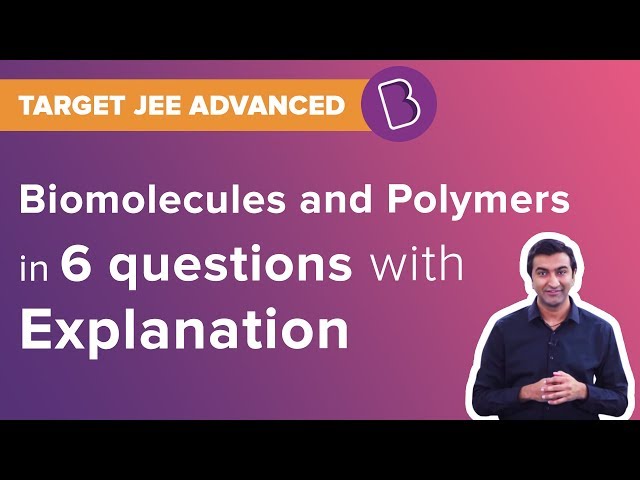Polymers JEE Advanced Previous Year Questions with Solutions will serve as a great last-minute preparation tool for JEE aspirants. The different forms of questions and solutions given here will help students get acquainted with the different types of JEE advanced questions and their difficulty levels. Additionally, students can also test their preparation level and practice solving problems. With this set of questions, students will also be able to have a quick revision of the topics and also understand which concepts are important from an exam perspective. All of this will be crucial in successfully completing the exam preparation.
Additionally, the Polymers JEE Advanced Previous Year Questions with Solutions can be downloaded in a PDF format for free from the website. Start preparing for the entrance exam with the help of previous years’ JEE advanced chapterwise questions and solutions.
Download Polymers Previous Year Solved Questions PDF
JEE Advanced Previous Year Questions on Polymers
Question 1. On complete hydrogenation, natural rubber produces.
A. Polyethylene
B. Ethylene-propylene copolymer
C. Polyvinyl chloride
D. Polypropylene
Solution: (B)
Natural rubber forms due to the polymerisation of isoprene and when hydrogenation occurs it leads to the formation of polymer of ethylene, propylene.

Question 2. Choose the correct option(s) from the following
A. Nylon-6 has amide linkages
B. Teflon is prepared by heating tetrafluoroethylene in presence of a persulphate catalyst at high pressure
C. Cellulose has only α-D-glucose units that are joined by glycosidic linkages
D. Natural rubber is polyisoprene containing trans alkene units
Solution: (A and B)
(A) Nylon-6 is a polyamide formed by heating caprolactam with water at 533 – 543 K.
(B) Teflon is polytetrafluoroethylene which is an addition polymer catalysed by persulphate.
Question 3. Which one of the following structures represents the neoprene polymer?

Solution: (C)
The structure of the neoprene polymer is as shown below.

Neoprene is obtained from chloroprene which is 2-chloro buta-1,3-diene. It is an addition homopolymer with a rubber-like structure and properties.
Question 4. The total number of lone-pair of electrons in melamine is ___.
Solution: (6)
If we look at the diagram given below, the total number of lone pairs in melamine is 6.

Each N uses 3 bonds and hence has 1 lone pair. Hence total of 6 lone pairs.
Question 5. Match the chemical substances in Column I with the type of polymers/type of bond in Column II.
| Column I | Column II |
|---|---|
| (A) Cellulose | (p) Natural polymer |
| (B) Nylon-66 | (q) Synthetic polymer |
| (C) Protein | (r) Amide linkage |
| (D) Sucrose | (s) Glycoside linkage |
Solution:
A – 1, 4
B – 2, 3
C – 1, 3
D – 4
A. Cellulose is a natural polymer found in wood, paper, cotton, etc. Its structure contains β(1 → 4) glycosidic linkage bonds.
B. Nylon-6, 6 is synthetic polyamide, synthesized by polycondensation of hexamethylenediamine and adipic acid.
C. Proteins are large biomolecules (natural polymers) consisting of one or more long chains of amino acid residues.
D. Sucrose (C12H 22O11) is a disaccharide combination of the monosaccharides glucose and fructose linked by (C1 − C2) glycosidic linkage.
Question 6. Among cellulose, polyvinyl chloride, nylon and natural rubber, the polymer in which the following intermolecular force of attraction is weakest?
A. Nylon
B. Polyvinyl chloride
C. Cellulose
D. Natural rubber
Solution: (D)
Natural rubber is a hydrocarbon and has the weakest intermolecular force of attraction, i.e. van der Waals’ force of attraction.
Question 7. Under hydrolytic conditions, the compounds used for the preparation of the linear polymer and for chain termination respectively are:
A. CH3SiCl3 and Si(CH3)4
B. (CH3)2SiCl2 and (CH3)3SiCl
C. (CH3)2SiCl2 and CH3SiCl3
D. SiCl4 and (CH3)3SiCl
Solution: (B)
(CH3)2SiCl2 r linear polymerization and (CH3)3SiCl for chain termination.
Question 8. The correct functional group X and the reagent//reaction conditions Y in the following scheme are:

A. X = COOCH3, Y = H2 / Ni / heat
B. X = CONH2, Y = H2 / ni/ heat
C. X = CONH2, Y = Br2 / NaOH
D. X = CN, Y = H2 / Ni / heat
Solution: (All of them)
A. 
B. 
C. 
D. 
Question 9. Give the structures of each of the products in each of the following reactions:

Solution:

(ii)

Question 10. Sulphur is used in the vulcanization of rubbers.
A. True
B. False
Solution: (A)
Vulcanization of rubber involves heating it in the presence of sulphur. This results in cross-linking of the chains of rubber and sulphur to form a stable polymer that is more strong and stable.
Biomolecules and Polymers

Comments